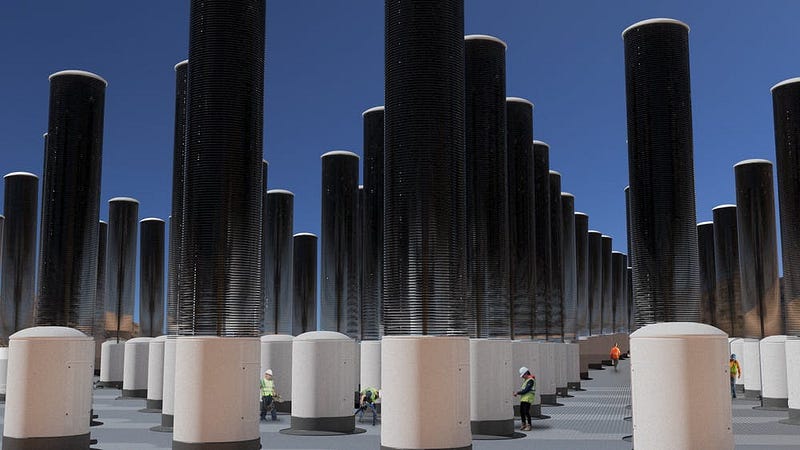Innovative Mechanical Trees: A Game Changer for Climate Action
Written on
The Promise of Mechanical Trees
The urgent issue of climate change is akin to an uncontrollable beast, threatening our planet's survival. Our reliance on carbon-emitting technologies—from transportation to manufacturing—has fueled this crisis, leading us toward a potential mass extinction. The question arises: how do we tackle this monumental problem? While planting more trees could help absorb carbon dioxide, the land required for such a vast undertaking could lead to further environmental issues. Fortunately, one scientist has proposed a remarkable solution: mechanical trees that might outperform their natural counterparts. Are these innovations the key to our climate salvation?
What Exactly Are Mechanical Trees?
Unlike traditional trees that rely on photosynthesis to convert sunlight, water, and carbon dioxide into energy, mechanical trees operate differently. They extract carbon dioxide directly from the atmosphere and store it. In theory, a single mechanical tree can absorb thousands of times more carbon dioxide than a regular tree.

These mechanical structures stand out visually. With a cylindrical base measuring 2.5 meters in width and a height of 10 meters, they feature a retractable concertina of 150 disks at the top. These disks are crafted from a specialized catalyst designed to bind exclusively to carbon dioxide. After capturing CO2 for 20 minutes to an hour, the catalyst is retracted back into the base, which then creates a vacuum to release the pure carbon dioxide.
The captured carbon can be transported to storage sites for safe containment or repurposed for industrial applications, providing a carbon-neutral alternative to traditional fossil fuel-derived carbon. It could even be transformed into biofuels like gasoline, diesel, or kerosene!
Comparing Effectiveness: Mechanical vs. Natural
To put the effectiveness of mechanical trees into perspective, consider that a mature oak, pine, or spruce tree captures roughly 6 grams (0.2 ounces) of carbon dioxide daily, which it uses for growth. However, when the tree dies, a significant portion of the stored carbon is released back into the atmosphere.
In contrast, a mechanical tree of similar size can capture approximately 83.33 kg (183.7 lbs) of carbon dioxide in just one day—making it nearly 14,000 times more efficient!
What’s even more promising is that mechanical trees consume very little energy. This efficiency could open avenues for profit, whether through selling captured carbon to industries or receiving government incentives to offset emissions. Currently, the financial details remain closely guarded, but if the cost of capturing carbon can be driven down to around $100 per tonne, this technology could become economically viable.

Klaus Lackner, the founder behind this innovation, envisions reaching this price point within the next decade by ramping up production. This could pave the way for an effective, scalable, and economically viable carbon capture solution.
To assess the feasibility of these mechanical trees, let’s consider the carbon emissions of 2020, which totaled approximately 36 billion tonnes. Each mechanical tree can absorb around 30.4 tonnes of carbon annually, meaning we would need about 1.8 billion mechanical trees to offset those emissions. While this number seems daunting, the compact design of these trees requires only 6.25 square meters (67.27 square feet) each. A mechanical tree farm occupying 7,375 square kilometers (2,847.5 square miles) could offset all carbon emissions, an area comparable to the size of the US Minor Outlying Islands or half of the Bahamas.

In comparison, utilizing hemp for carbon capture would necessitate converting 27% of the Earth's land area into hemp farms—significantly more than the 0.1% required for mechanical trees. Carbon Collect, the company behind this technology, aims to establish over 250 farms by the decade's end, although this would only capture around 3% of fossil fuel emissions.
Challenges Ahead
However, the journey to widespread adoption of mechanical trees is fraught with challenges. Producing over a billion of these devices will consume substantial energy and resources, potentially emitting considerable carbon during the initial setup. While the trees can offset emissions, this lag could hinder their overall effectiveness.
Additionally, managing the 36 billion tonnes of carbon dioxide we aim to capture poses a dilemma. Proper storage is crucial, yet converting carbon dioxide into stable materials, like pure carbon, requires even more energy and resources. This could lead to bottlenecks, where we may struggle to store carbon quickly enough to keep pace with the mechanical trees.
Despite these hurdles, the efficiency and compact nature of mechanical trees offer a glimmer of hope in the fight against climate change. This technology could not only halt global warming but also help reverse the damage done to our planet within our lifetimes. The prospect of a carbon-neutral future for humanity appears more attainable than ever, providing a reason for optimism.
The Climate Change Solution Tier List! feat. @EngineeringwithRosie - This video discusses various solutions to climate change, including innovative technologies like mechanical trees.
Unicorn Hunters - Episode 5 - MechanicalTrees™ - Carbon Collect - This episode explores the concept of mechanical trees and their potential impact on carbon capture and climate change solutions.